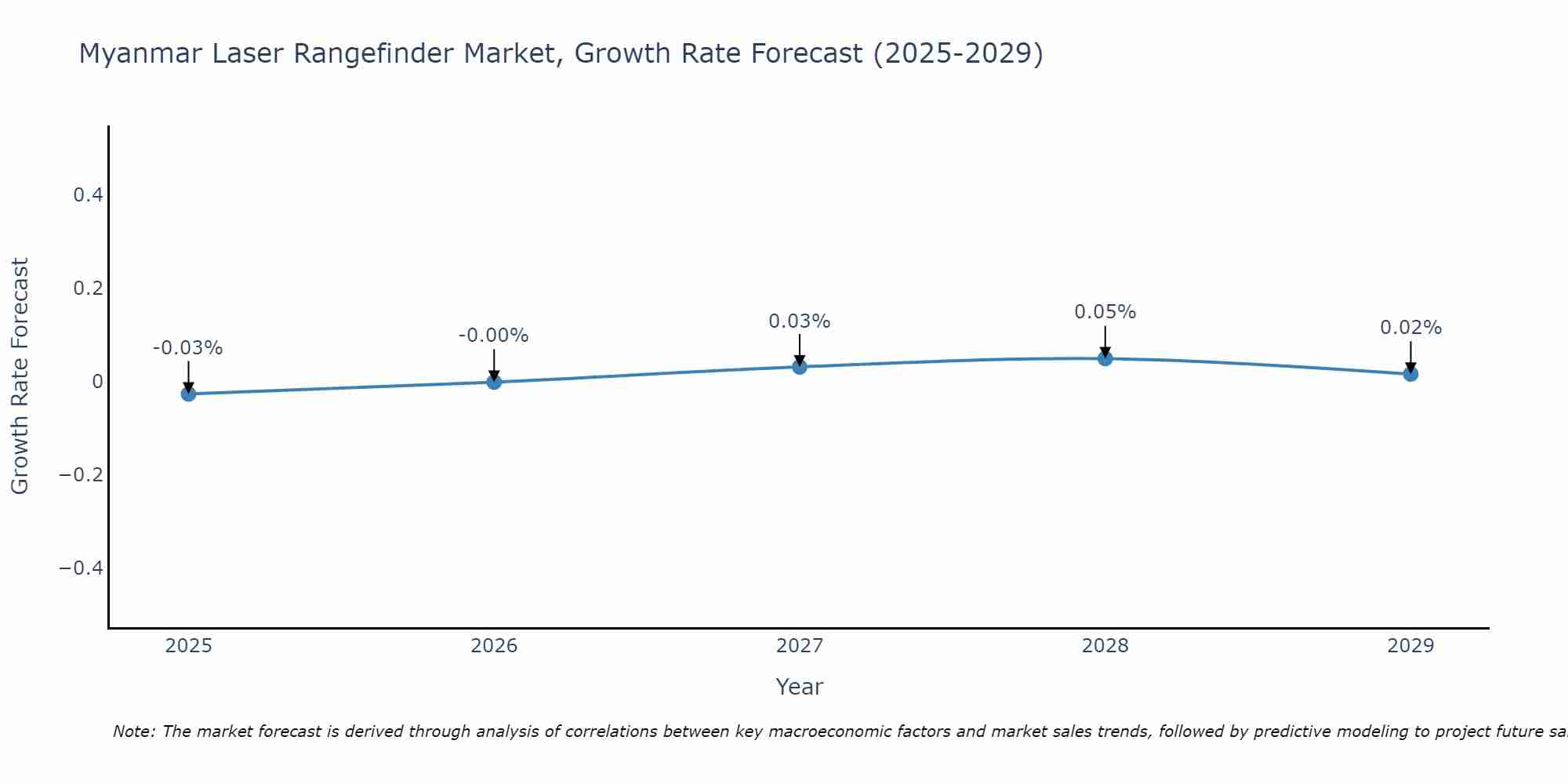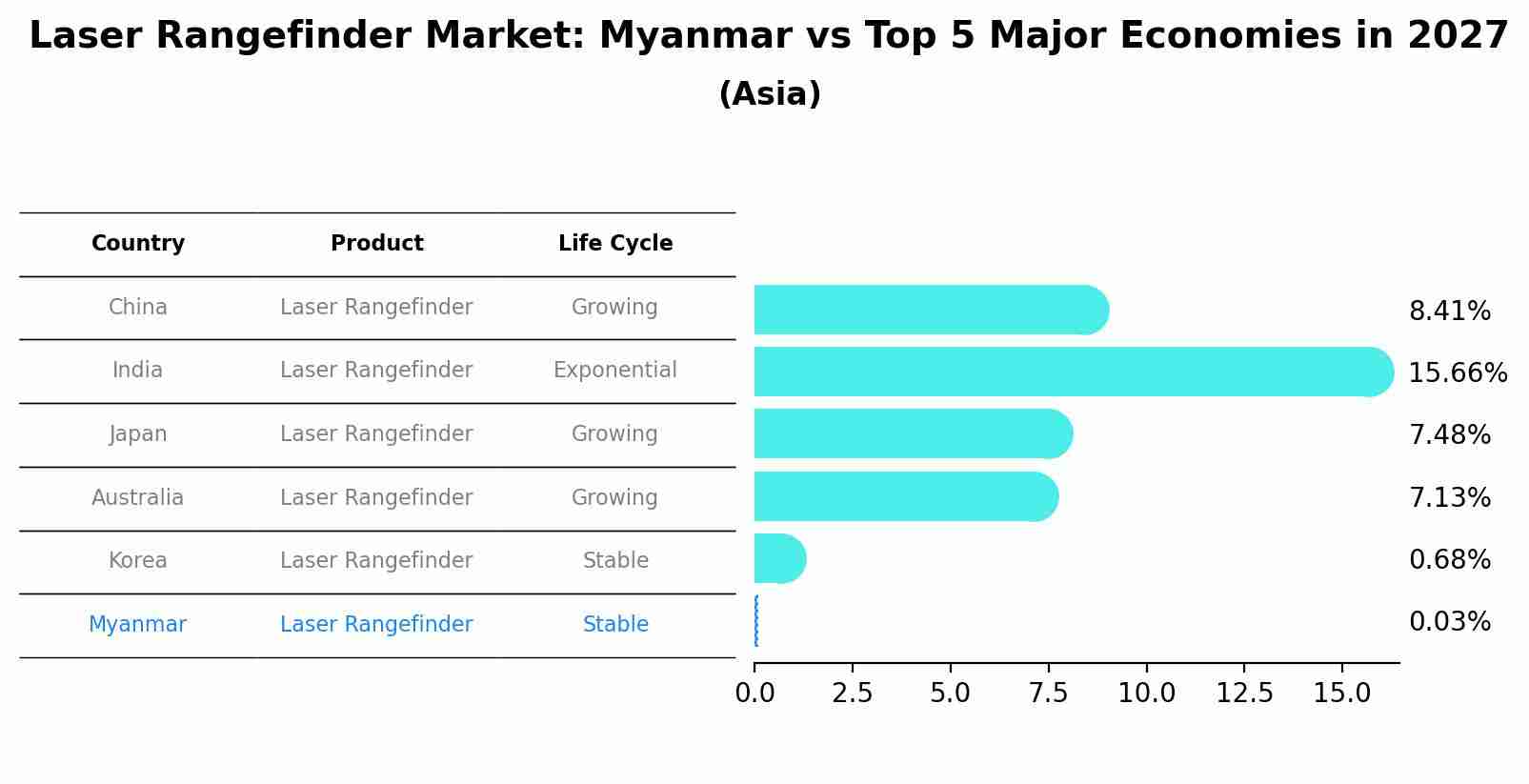Myanmar Laser Rangefinder Market Outlook | Size, Share, Industry, Forecast, Analysis, Revenue, Trends, Companies, COVID-19 IMPACT, Growth & Value
| Product Code: ETC365974 | Publication Date: Aug 2022 | Updated Date: Aug 2025 | Product Type: Market Research Report | |
| Publisher: 6Wresearch | Author: Shubham Padhi | No. of Pages: 75 | No. of Figures: 35 | No. of Tables: 20 |
Myanmar Laser Rangefinder Market Size Growth Rate
The Myanmar Laser Rangefinder Market is projected to witness mixed growth rate patterns during 2025 to 2029. Starting at -0.03% in 2025, the market peaks at 0.05% in 2028, and settles at 0.02% by 2029.

Laser Rangefinder Market: Myanmar vs Top 5 Major Economies in 2027 (Asia)
Myanmar's Laser Rangefinder market is anticipated to experience a stable growth rate of 0.03% by 2027, reflecting trends observed in the largest economy China, followed by India, Japan, Australia and South Korea.

Myanmar Laser Rangefinder Market Overview
The laser rangefinder market in Myanmar is witnessing growth with the increasing adoption of laser-based ranging and targeting systems in defense, surveying, and outdoor recreational activities. Laser rangefinders accurately measure distances using laser technology, making them essential tools for military operations, land surveying, and hunting. The market expansion is driven by the need for precise distance measurement and targeting solutions.
Drivers of the market
The expanding applications of laser rangefinders in defense, forestry, construction, and outdoor sports drive the growth of the laser rangefinder market in Myanmar. Laser rangefinders provide accurate distance measurements by emitting laser pulses and calculating the time taken for the pulses to return after reflecting off targets. Moreover, the increasing focus on precision targeting, surveying, and distance measurement tasks fuels the adoption of laser rangefinders. Additionally, the development of compact and lightweight rangefinder models with enhanced features such as long-range capabilities and angle compensation further stimulates market growth in Myanmar.
Challenges of the market
Challenges in the laser rangefinder market in Myanmar include limited adoption of laser ranging technology, concerns over product accuracy and reliability, and competition from alternative distance measuring devices. Moreover, affordability issues and lack of specialized applications hinder market growth.
Government Policy of the market
Recognizing the applications of laser rangefinders in various sectors such as defense, surveying, and construction, the government has introduced policies to regulate and support the laser rangefinder market. These policies include standards for product accuracy and safety, incentives for local production and importation of laser rangefinders, and measures to promote training and certification for professionals using rangefinder technology.
Key Highlights of the Report:
- Myanmar Laser Rangefinder Market Outlook
- Market Size of Myanmar Laser Rangefinder Market, 2024
- Forecast of Myanmar Laser Rangefinder Market, 2031
- Historical Data and Forecast of Myanmar Laser Rangefinder Revenues & Volume for the Period 2018 - 2031
- Myanmar Laser Rangefinder Market Trend Evolution
- Myanmar Laser Rangefinder Market Drivers and Challenges
- Myanmar Laser Rangefinder Price Trends
- Myanmar Laser Rangefinder Porter's Five Forces
- Myanmar Laser Rangefinder Industry Life Cycle
- Historical Data and Forecast of Myanmar Laser Rangefinder Market Revenues & Volume By Type for the Period 2018 - 2031
- Historical Data and Forecast of Myanmar Laser Rangefinder Market Revenues & Volume By Telescope Later Rangefinder for the Period 2018 - 2031
- Historical Data and Forecast of Myanmar Laser Rangefinder Market Revenues & Volume By Hand-held Later Rangefinder for the Period 2018 - 2031
- Historical Data and Forecast of Myanmar Laser Rangefinder Market Revenues & Volume By Application for the Period 2018 - 2031
- Historical Data and Forecast of Myanmar Laser Rangefinder Market Revenues & Volume By Military for the Period 2018 - 2031
- Historical Data and Forecast of Myanmar Laser Rangefinder Market Revenues & Volume By Construction for the Period 2018 - 2031
- Historical Data and Forecast of Myanmar Laser Rangefinder Market Revenues & Volume By Industrial for the Period 2018 - 2031
- Historical Data and Forecast of Myanmar Laser Rangefinder Market Revenues & Volume By Sports for the Period 2018 - 2031
- Historical Data and Forecast of Myanmar Laser Rangefinder Market Revenues & Volume By Forestry for the Period 2018 - 2031
- Historical Data and Forecast of Myanmar Laser Rangefinder Market Revenues & Volume By Others for the Period 2018 - 2031
- Myanmar Laser Rangefinder Import Export Trade Statistics
- Market Opportunity Assessment By Type
- Market Opportunity Assessment By Application
- Myanmar Laser Rangefinder Top Companies Market Share
- Myanmar Laser Rangefinder Competitive Benchmarking By Technical and Operational Parameters
- Myanmar Laser Rangefinder Company Profiles
- Myanmar Laser Rangefinder Key Strategic Recommendations
Frequently Asked Questions About the Market Study (FAQs):
- Single User License$ 1,995
- Department License$ 2,400
- Site License$ 3,120
- Global License$ 3,795
Search
Related Reports
- ASEAN Bearings Market (2025-2031) | Strategy, Consumer Insights, Analysis, Investment Trends, Opportunities, Growth, Size, Share, Industry, Revenue, Segments, Value, Segmentation, Supply, Forecast, Restraints, Outlook, Competition, Drivers, Trends, Demand, Pricing Analysis, Competitive, Strategic Insights, Companies, Challenges
- Europe Flooring Market (2025-2031) | Outlook, Share, Industry, Trends, Forecast, Companies, Revenue, Size, Analysis, Growth & Value
- Saudi Arabia Manlift Market (2025-2031) | Outlook, Size, Growth, Trends, Companies, Industry, Revenue, Value, Share, Forecast & Analysis
- Uganda Excavator, Crane, and Wheel Loaders Market (2025-2031) | Strategy, Consumer Insights, Analysis, Investment Trends, Opportunities, Growth, Size, Share, Industry, Revenue, Segments, Value, Segmentation, Supply, Forecast, Restraints, Outlook, Competition, Drivers, Trends, Demand, Pricing Analysis, Competitive, Strategic Insights, Companies, Challenges
- Rwanda Excavator, Crane, and Wheel Loaders Market (2025-2031) | Strategy, Consumer Insights, Analysis, Investment Trends, Opportunities, Growth, Size, Share, Industry, Revenue, Segments, Value, Segmentation, Supply, Forecast, Restraints, Outlook, Competition, Drivers, Trends, Demand, Pricing Analysis, Competitive, Strategic Insights, Companies, Challenges
- Kenya Excavator, Crane, and Wheel Loaders Market (2025-2031) | Strategy, Consumer Insights, Analysis, Investment Trends, Opportunities, Growth, Size, Share, Industry, Revenue, Segments, Value, Segmentation, Supply, Forecast, Restraints, Outlook, Competition, Drivers, Trends, Demand, Pricing Analysis, Competitive, Strategic Insights, Companies, Challenges
- Angola Excavator, Crane, and Wheel Loaders Market (2025-2031) | Strategy, Consumer Insights, Analysis, Investment Trends, Opportunities, Growth, Size, Share, Industry, Revenue, Segments, Value, Segmentation, Supply, Forecast, Restraints, Outlook, Competition, Drivers, Trends, Demand, Pricing Analysis, Competitive, Strategic Insights, Companies, Challenges
- Israel Intelligent Transport System Market (2025-2031) | Strategy, Consumer Insights, Analysis, Investment Trends, Opportunities, Growth, Size, Share, Industry, Revenue, Segments, Value, Segmentation, Supply, Forecast, Restraints, Outlook, Competition, Drivers, Trends, Demand, Pricing Analysis, Competitive, Strategic Insights, Companies, Challenges
- Uganda Precast and Aggregate Market (2025-2031) | Strategy, Consumer Insights, Analysis, Investment Trends, Opportunities, Growth, Size, Share, Industry, Revenue, Segments, Value, Segmentation, Supply, Forecast, Restraints, Outlook, Competition, Drivers, Trends, Demand, Pricing Analysis, Competitive, Strategic Insights, Companies, Challenges
- Australia IT Asset Disposal Market (2025-2031) | Strategy, Consumer Insights, Analysis, Investment Trends, Opportunities, Growth, Size, Share, Industry, Revenue, Segments, Value, Segmentation, Supply, Forecast, Restraints, Outlook, Competition, Drivers, Trends, Demand, Pricing Analysis, Competitive, Strategic Insights, Companies, Challenges
Industry Events and Analyst Meet
Our Clients
Whitepaper
- Middle East & Africa Commercial Security Market Click here to view more.
- Middle East & Africa Fire Safety Systems & Equipment Market Click here to view more.
- GCC Drone Market Click here to view more.
- Middle East Lighting Fixture Market Click here to view more.
- GCC Physical & Perimeter Security Market Click here to view more.
6WResearch In News
- Doha a strategic location for EV manufacturing hub: IPA Qatar
- Demand for luxury TVs surging in the GCC, says Samsung
- Empowering Growth: The Thriving Journey of Bangladesh’s Cable Industry
- Demand for luxury TVs surging in the GCC, says Samsung
- Video call with a traditional healer? Once unthinkable, it’s now common in South Africa
- Intelligent Buildings To Smooth GCC’s Path To Net Zero













